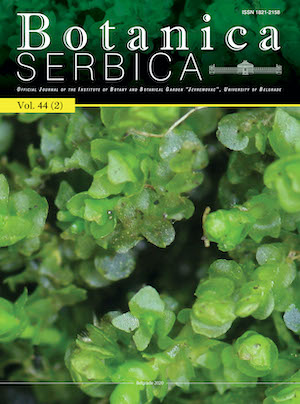
Volume 44 Issue 2 2020 |
Diversity and the role of endophytic bacteria: a review
|
KEY WORDS: endophytes, biological roles, histological localisation, biocontrol, antimicrobial activity |
CRISPR/Cas-based genome editing to improve abiotic stress tolerance in plants
|
KEY WORDS: CRISPR/Cas system, climate change, drought, salt, high temperature |
Intraspecific variability of some functional traits of Trigonocaryum involucratum (Steven) Medw., a Caucasus endemic plant
|
KEY WORDS: leaf functional traits, specific leaf area (SLA), Myosotis involucrata, Dagestan, the North Caucasus |
Morphological variability of leaf and shoot traits of four barberry taxa (Berberis L.) from the Balkan Peninsula and Sicily
|
KEY WORDS: Berberidacae, Berberis aetnensis, Berberis cretica, Berberis croatica, Berberis vulgaris, morphology, morphometry, multivariate analysis, taxonomy |
Stress-induced carbon starvation in Rhizophora mucronata Lam. seedlings under conditions of prolonged submergence and water deficiency: survive or succumb
|
KEY WORDS: acclimation, mangrove, plant maintenance, growth, starch, total soluble sugars |
Effect of plant growth regulators and explants on callus induction and study of antioxidant potentials and phenolic metabolites in Salvia tebesana Bunge
|
KEY WORDS: antioxidant activity, callus induction, reducing power, polyphenols, Salvia tebesana, secondary metabolites |
Concentration- and time-dependent effects of strontium on Lens culinaris Medik
|
KEY WORDS: chromosome abnormalities, bioaccumulator, lentil, cytogenetic effects |
Physiological response of Moringa oleifera exposed to bisphenol A
|
KEY WORDS: bisphenol A, Moringa oleifera, growth, physiological effect |
Effect of N-acetyl-L-cysteine (NAC) on soluble sugar and polyamine content in wheat seedlings exposed to heavy metal stress (Cd, Hg and Pb)
|
KEY WORDS: leaf water potential, N-acetyl-L-cysteine, Triticum aestivum, osmolytes, stress tolerance |
Susceptibility of Serbian plum cultivars to indigenous bacterial and Monilinia laxa isolates
|
|
Variations in the water potential of stem xylem in Russian olive (Elaeagnus angustifolia) seedlings treated with mycorrhizal fungi under drought conditions
|
KEY WORDS: mycorrhizae, water potential, water stress, Elaeagnus angustifolia |
Jumping the barrier: does a glacier tongue affect species distribution along the elevation gradient in the subnival and nival belts? A case study on Mt. Kazbegi, Georgia, Central Great Caucasus Mountains
|
KEY WORDS: elevation gradient, available plant nutrients, plant diversity, subnival-nival vegetation patch |
Contribution to study of the pyrophilous fungi of Ukraine
|
KEY WORDS: biodiversity, distribution, Holosiivskyi National Nature Park, new records, Pezizales, post-fire fungi |
Records of lichen species new for Ukraine from steppe habitats of the country
|
KEY WORDS: Arthonia, Bacidia, Candelariella, Enchylium, Haematomma, Lecania, Lecidea, Ramalina, Sarcogyne, Xanthocarpia, loess, granite, limestone, bark |
New records and noteworthy data of plants, algae and fungi in SE Europe and adjacent regions, 2
|
KEY WORDS: new record, Clitocybe truncicola, Eunotia boreoalpina, Epipactis purpurata, Haplomitrium hookeri, Krascheninnikovia ceratoides, Leptodon smithii, Polygonum albanicum, Sorbus latifolia, Stipa tirsa, Typha laxmannii, Typha shuttleworthii |


